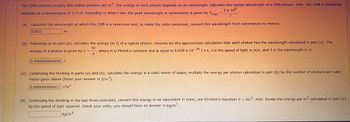The CMB contains roughly 400 million photons per m³. The energy of each photon depends on its wavelength. Calculate the typical wavelength of a CMB photon. Hint: The CMB is blackbody 3 x 106 radiation at a temperature of 2.73 K. According to Wien's law, the peak wavelength in nanometers is given by Amax (a) Calculate the wavelength at which the CMB is a maximum and, to make the units consistent, convert this wavelength from nanometers to meters. m
Stellar evolution
We may see thousands of stars in the dark sky. Our universe consists of billions of stars. Stars may appear tiny to us but they are huge balls of gasses. Sun is a star of average size. Some stars are even a thousand times larger than the sun. The stars do not exist forever they have a certain lifetime. The life span of the sun is about 10 billion years. The star undergoes various changes during its lifetime, this process is called stellar evolution. The structure of the sun-like star is shown below.
Red Shift
It is an astronomical phenomenon. In this phenomenon, increase in wavelength with corresponding decrease in photon energy and frequency of radiation of light. It is the displacement of spectrum of any kind of astronomical object to the longer wavelengths (red) side.

Trending now
This is a popular solution!
Step by step
Solved in 2 steps with 3 images

Hello! can you please assist with D?
& For reference:
A = 0.0011 m
B = 1.807 x 10^-22 J
C = 7.228 x 10^-14 J/m^3

Hi, can you please assist with C?
& For reference:
A = 0.0011 m
B = 1.807 x 10^-22 J










